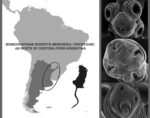Evidences of non-lethal rabies virus exposure in free-ranging wild carnivores from Brazilian Pampa
Thamiris Padilha, Helena B.C.R. Batista, Andrea C.R. Silva, Rene S. Cunha-Neto, Karin C. Scheffer, Ugo Souza, Felipe B. Peters, Fernanda Marks, Aline A.S. Campos, Maria Ogrzewalska, Márcia M.A. Jardim, Tatiane C. Trigo, José ReckRabies virus (RABV) may infect wildlife, domestic mammals, and humans worldwide, and outbreaks have been associated with population declines of wild carnivores. Although RABV infection has been considered almost invariably fatal, there has been growing evidence of non-lethal RABV exposure in wildlife. The aim of this study is to investigate the occurrence of RABV antibodies, as evidence of non-lethal exposure to the virus in free-living wild canids and felids from the Brazilian Pampa. Animals were live-trapped in three protected and two unprotected areas in Southern Brazil, and the presence of antibodies against RABV was verified by the RFFIT test. A total of 98 specimens without clinical signs of disease were live-trapped: 35 Cerdocyon thous, 23 Lycalopex gymnocercus, 29 Leopardus geoffroyi, 11 Leopardus wiedii. Thirteen out of 98 wild carnivores were considered seropositive to RABV: five C. thous, one L. gymnocercus, five L. geoffroyi, and two L. wiedii. All five localities where animals were sampled had at least one seropositive individual. The results support previous conclusions regarding the possible involvement of C. thous in the rabies ecology and expand the findings of RABV-seropositivity in free-living wildlife, representing the first record for the following species: L. gymnocercus, L. geoffroyi, and L. wiedii. Our findings also suggest that RABV circulation and non-lethal exposure in Neotropical wild carnivores may be more common than previously assumed. Furthermore, rabies and its sylvatic cycle should be taken into account in any conservation effort for wild carnivores.
Evidências de exposição não-letal ao vírus da raiva em carnívoros silvestres de vida livre no Pampa brasileiro. O vírus da Raiva (RABV) pode infectar mamíferos silvestres, domésticos e humanos em todo o mundo, e surtos têm sido associados com declínios populacionais em carnívoros silvestres. Apesar da infecção pelo RABV ser considerada invariavelmente fatal, há evidências crescentes de exposição não-letal em animais silvestres. O objetivo deste trabalho é investigar a ocorrência de anticorpos contra RABV, como evidência de exposição não-letal ao vírus em canídeos e felídeos de vida livre no Pampa brasileiro. Os animais foram capturados em três áreas de preservação e duas áreas não-protegidas do Sul do Brasil, e a presença de anticorpos contra RABV foi verificada por RFFIT. Um total de 98 espécimes sem sinais de doença foram capturados: 35 Cerdocyon thous, 23 Lycalopex gymnocercus, 29 Leopardus geoffroyi e 11 Leopardus wiedii. Treze dos 98 carnívoros silvestres foram considerados soropositivos para RABV: cinco C. thous, um L. gymnocercus, cinco L. geoffroyi, e dois L. wiedii. Todas as cinco localidades onde os animais foram amostrados apresentaram ao menos um indivíduo soropositivo. Os resultados corroboram conclusões anteriores sobre o possível envolvimento de C. thous na ecologia da raiva, e expandem os achados de soropositividade para RABV em animais silvestres, representando o primeiro registro para as seguintes espécies: L. gymnocercus, L. geoffroyi e L. wiedii. Nossos resultados também sugerem que a circulação do RABV e a exposição não-letal em carnívoros silvestres neotropicais pode ser mais comum do que previamente assumido. Outrossim, a raiva e seu ciclo silvestre devem ser levados em consideração em qualquer esforço de conservação de carnívoros silvestres.





